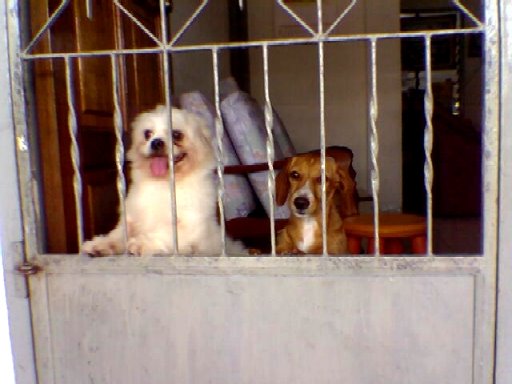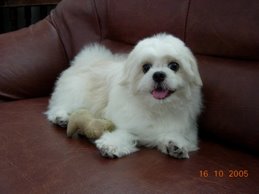Top 10 Reasons Why Dogs Get Itchy
Here's a list of the Top 10 Reasons Why Doggies Get Itchy:
Itching is one of the most unpleasant sensations imaginable - and a dog's never-ending scratching, biting, and licking can seem nearly as aggravating. If your pet is constantly shaking their head, or scratching, rubbing, chewing or licking some area of skin, you can bet that there's likely some agonizing itching going on. Left untreated, areas of itchy skin become vulnerable to damage from your pet's scratching or licking, to hot spots (areas of oozing, dry or inflamed skin), and even to secondary infections from bacteria. What may be causing the itch, and what can you do about it? Here's a list of the top ten itch-causing factors. Are any of these going on at your house?
1. Poor Quality Diet - We're not talking about food allergies here (more on that shortly). A surprising factor underlying a vast number of allergic itch reactions is simply a poor quality diet that inadequately nourishes your dog. A good diet is the foundation of good health. Even the best medication won't eliminate allergic skin reactions when your pet's immune system is unable to function properly due to lack of nutrients. A good daily multivitamin is a great way to enhance the nutrient levels your pet gets each day as well.
2. Airborne Allergens - Most cases of itchy skin are caused by the same things that cause human allergies (dust, grasses, pollen, etc.). While humans sneeze and have other respiratory symptoms, pets usually develop atopic dermatitis, showing their allergic reaction through their skin. While this is a major cause of pets' itching, airborne allergies are tough to diagnose, and other causes usually need to be ruled out first. Remember that just like humans, pets can be allergic to both natural allergens like pollen and chemical irritants like pesticide residue and household cleaning products.
3. Food Allergies - While making up only about 10% of diagnosed allergies, food allergies are considered by many holistic vets to be the primary cause of about 30% of allergy cases in pets. This is due to how allergies activate your pet's immune system. Pets sensitive to one food allergen (commonly grain-based proteins called glutens) can become hyper-reactive to other allergens like dust or pollen. Fortunately, food allergies can be resolved with diligent detective work, eliminating all common allergens from the diet (beef, chicken, eggs, corn, wheat, soy, and milk), then reintroducing one at a time to see which ones cause an allergic reaction.
4. Contact Dermatitis - Some cases of itchy skin in pets is caused by direct skin contact with irritating substances. Common causes of contact dermatitis include flea collars and topical flea and tick preparations, grooming products, and household cleaners that pets contact through their skin - especially through the pads of their feet. As with food allergies, removing suspect products from any contact with your pet's skin can help determine what's causing the itch.
5. Fleas, Mites and Insect Bites - The most common allergy that causes itchy skin in pets (usually around the base of the tail and hindquarters) is flea bite dermatitis, an allergic reaction to flea saliva that can be triggered by only one flea bite! This can be frustrating for pet parents because a single flea bite can cause a severe reaction, yet you may never see a full blown flea infestation. If you live in an area where fleas are present, always keep in mind that one flea can cause some furious itching in your pet. Your vet can help you determine what degree of flea protection you need to keep your pet safe and healthy, but remember that natural solutions for insect control are the safest way to go and are well worth a try if you live in an area known for flea problems.
6. Skin Infections - Three main types of skin infections can cause itching in pets. Bacterial infection is often a secondary problem created by a cat or dog scratching, licking or biting an already irritated area of skin. These skin infections can be painful as well as increasing the itch factor. Ringworm, a fungal infection, is not uncommon - and it's contagious to humans! Ringworm commonly appears as areas of broken or crusty skin, with hair loss, usually around the head, face, or extremities. A vet can test your pet if ringworm is suspected. Another fungus problem is due to a yeast infection on the skin. This chronic itch problem commonly occurs on the paws or in the ears, and is often accompanied by yeast overgrowth in the digestive tract.
7. Genetic Factors & Breed Predisposition - Unfortunately, some breeds of cats and dogs are more prone to sensitive skin, or are more likely to develop allergic itching due to skin folds and ear shapes. Many breeds of dogs including Labrador and Golden Retrievers, Boxers, Shih Tzus, and many Terrier breeds are more prone to allergies that cause itching skin. Dogs with skin folds and floppy ears are more likely to develop itching from yeast or bacterial infections due to the ideal environment their anatomical features offer to these opportunistic microbes. Another related factor is temperament, with sensitive, high-strung breeds being more prone to reactive health conditions like allergies. The mind-body connection operates in pets as well as humans!
8. Vaccine Reactions - Although still controversial and not uniformly acknowledged by all pet health professionals, incidences of over-vaccination, and even single dose vaccine reactions are becoming more recognized and well-documented in pets. Vaccines are designed to cause a reaction in the immune system, and for some pets, the protein base of the vaccine serum can cause pets to develop allergies. In other cases, multiple vaccines administered together can overwhelm the immune system, resulting in "vaccinosis," a condition commonly known to trigger allergic symptoms like itchy skin.
9. Glandular/Hormonal Imbalances - Several glandular imbalances can cause skin problems that contribute to itching in some pets. Two of the most common are related to thyroid and adrenal gland functioning. Hypothyroidism (low thyroid function) is more common in dogs than in cats, but cases are found in both species. Hypothyroidism can cause the skin to become greasy, foul smelling, and in some cases very itchy. Cushing's Disease (more correctly called Hyperadrenocorticism) is caused by adrenal gland overactivity, and commonly occurs in older dogs, where numerous skin problems that can cause itching may occur. These are serious health issues that require vet treatment, so always check with your vet when unusual skin issues or other symptoms arise.
10. Detoxification Effects - The skin is an important organ of elimination, and one of the ways that pets may remove toxic residues from their systems is through their skin. If your pet has a temporary bout of itching, it may be a simple healing process as the body rids itself of residues its been storing up. This is a very common phenomenon when pets change from pharmaceutical to holistic remedies, or when their food is upgraded. Typically, a period of itchy skin, change in stool odor, consistency and volume, and/or runny nose can occur as part of a healing crisis when pets are going through a natural and healthy detoxification process. These periods generally don't last long, and should resolved within 1-4 weeks, depending on the state of health your companion.
This Article is Taken From: Tease The Maltese's Celebrity Dog Blog
































.jpg)






.jpg)
